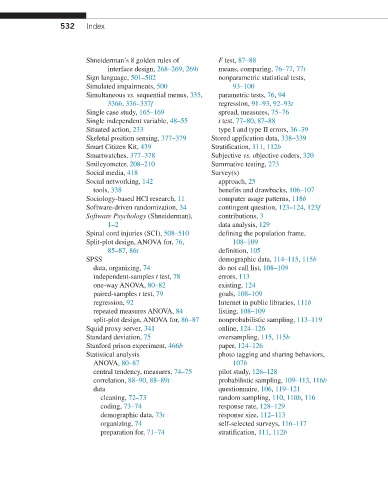Page 539 -
P. 539
532 Index
Shneiderman’s 8 golden rules of F test, 87–88
interface design, 268–269, 269t means, comparing, 76–77, 77t
Sign language, 501–502 nonparametric statistical tests,
Simulated impairments, 500 93–100
Simultaneous vs. sequential menus, 335, parametric tests, 76, 94
336b, 336–337f regression, 91–93, 92–93t
Single case study, 165–169 spread, measures, 75–76
Single independent variable, 48–55 t test, 77–80, 87–88
Situated action, 233 type I and type II errors, 36–39
Skeletal position sensing, 377–379 Stored application data, 338–339
Smart Citizen Kit, 439 Stratification, 111, 112b
Smartwatches, 377–378 Subjective vs. objective coders, 320
Smileyometer, 208–210 Summative testing, 273
Social media, 418 Survey(s)
Social networking, 142 approach, 25
tools, 338 benefits and drawbacks, 106–107
Sociology-based HCI research, 11 computer usage patterns, 118b
Software-driven randomization, 34 contingent question, 123–124, 123f
Software Psychology (Shneiderman), contributions, 3
1–2 data analysis, 129
Spinal cord injuries (SCI), 508–510 defining the population frame,
Split-plot design, ANOVA for, 76, 108–109
85–87, 86t definition, 105
SPSS demographic data, 114–115, 115b
data, organizing, 74 do not call list, 108–109
independent-samples t test, 78 errors, 113
one-way ANOVA, 80–82 existing, 124
paired-samples t test, 79 goals, 108–109
regression, 92 Internet in public libraries, 111b
repeated measures ANOVA, 84 listing, 108–109
split-plot design, ANOVA for, 86–87 nonprobabilistic sampling, 113–119
Squid proxy server, 341 online, 124–126
Standard deviation, 75 oversampling, 115, 115b
Stanford prison experiment, 466b paper, 124–126
Statistical analysis photo tagging and sharing behaviors,
ANOVA, 80–87 107b
central tendency, measures, 74–75 pilot study, 126–128
correlation, 88–90, 88–89t probabilistic sampling, 109–113, 116b
data questionnaire, 106, 119–121
cleaning, 72–73 random sampling, 110, 110b, 116
coding, 73–74 response rate, 128–129
demographic data, 73t response size, 112–113
organizing, 74 self-selected surveys, 116–117
preparation for, 71–74 stratification, 111, 112b

